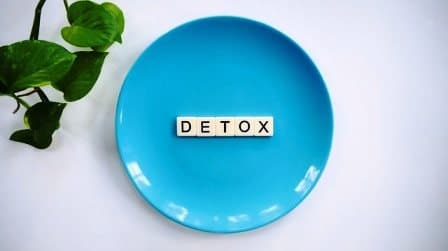
Last Updated on February 24, 2021 by admin
Body Detox is a popular term that is used most often by many spiritual gurus, yogis, nutritionists. In Ayurveda, body detoxification was mentioned many thousands of years back and has been doing by Ayurveda experts then. Procedures are done as mentioned in the classics of Ayurveda. The main principle is still the same, the only difference is the modern-day tools are used nowadays. Toxins are removed from the body using herbal preparations and procedures.
Detoxification is the process of elimination of toxins from the body. In Ayurveda, detoxification is called “sodhana karma“. Sodhana is the purification and karma is the procedure.
Sodhana according to Ayurveda: The procedures by which vitiated vatadi dosas are removed from the body is known as sodhana (Arunadutta)
Toxins can accumulate in our body in many ways, from our foods like “Virudha ahaar“. Virudha ahaar are the foods like heavy oily foods, unpleasant foods, excessive cold food, contaminated foods. Toxins can also add up in our bodies from the changes in our lifestyle. The number of people consuming alcohol, cigarettes is increasing. These substances cause toxicity in the body. Morbid elements are added to our body and the body suffers a lot. We need to eliminate these toxins to remain healthy.
In Ayurveda, detoxication is very important prior to any treatment. In Ayurveda, food is considered medicine. What we eat is what we are. Those toxin-causing substances are ama(undigested foods) and mala(waste materials). According to Ayurveda medicine is of no use if disease-causing morbid substances are not removed first.
Mala is generally excreted from our body by body mechanism as stool, urine, sweat. But, ama is not excreted on their own and if they get into the body system can cause various ailments.
These ama needs to be eliminated. Otherwise, ama will go transformation to body elements that can disturb the balance of the body dosas.
Before going into detail, we should know “how the mechanism of biotransformation works according to Ayurveda”. The food that we eat goes to amasaya(stomach) and then to grahani(small intestine) and to pakvasaya(large intestine). Agni or digestive enzymes help to convert foods to absorbable ones. With the help of bhutagni(digestive enzyme) food is converted from heterogeneous to homogenous particles. Dhatvagni(another digestive enzyme) helps in the transmission of dhatus(one body element to others). According to Ayurveda, there are seven dhatus. Rasa the first one is formed then rakta is formed, then mamsa, meda, asthi, majja, sukra so on.
This transmission is very important for the normal functioning of the body. But, if undigested food ama gets into this transformation can cause thirst, tremors, anorexia, dizziness, abdominal pain, vistambha(abdominal distention), sadana(extreme weakness), tenesmus, vomiting, fever, yawning, malaise.
To eliminate the undigested food or ama in Ayurveda many procedures are mentioned. These procedures come in the panchakarma treatment of Ayurveda.
why body detoxification (sodhana karma) is done?
It is done to eliminate toxins, to get a complete cure of disease, increase strength, increase complexion of skin, to get long life. (charaka samhita, 15/22)
Reasons why the food may be indigested is because of the vitiated digestive enzymes. The vitiation is caused by-
- Excessive fast, over-eating, irregular eating.
- Intake of unwholesome foods, cold foods, excessively un-unctuous or polluted foods.
- Improper administration of purgation, emetic, and oleation therapy.
- Emaciation from other diseases.
- Presence in a country with not suitable weather or in an inappropriate time.
- Suppression of natural urges.
Selection of the patient for sodhan karma
In Ayurveda, it is strictly mentioned on whom body detoxification should be performed. Selection of the yogya (eligible) and ayogya (ineligible) is very important to get the utmost result. Otherwise, harm will be done rather than doing good to the patient. Too old, too emaciated, very weak persons are always avoided for the detoxification process like emesis, purgation.
Importance of Season/time in sodhan karma
All the seasons of a year are not good for performing the panchakarma procedures. During the summer and rainy seasons, panchakarma is avoided. In winter vamana, virechana are avoided. In other seasons of the year, body detoxification can be done.
Preparing the body for detox
In Ayurveda, it is important to do purvakarma(preparatory procedure) before doing pradhan karma(the main procedure). This way it makes the body ready for the administration of drugs which will ultimately clean the gut. One more important benefit of the preparatory procedure is that toxins that are in the periphery system of the body and in the blood are brought to the gut. Otherwise, toxins in distant locations from the gut will not be eliminated.
These preparatory procedures are snehan(oleation therapy), swedan(hot fomentation), fasting. Oleation therapy is nothing but the application of medicated oil on the body according to body type(prakruti). These all procedures are preferred upon the patient’s condition. One may not go all through these procedures.
It is also to be noted that body detoxification can not be done in a day. The procedures follow well over a week. It is fact that toxins flow slowly from the distant system and then elimination through urdhamarga(through the mouth) or adhamarga(through the anus) takes time.
Elimination of the toxins from the body
Finally, the part elimination of toxins comes which is the pradhan karma(main procedure). In Ayurveda vamana, virachana, vasti procedures are mentioned. Toxins can either be eliminated through udhamarga or adhamarga. Panchakarma and sodhana are sometimes interchangeably used. But, sodhana is limited to detoxification of the body whereas panchakarma has other effects on the body too like bringhana (nourishment), samana (balancing), stambhana (cessation), rukshana (dehydration), utkleshana (aggravation), etc.
Sodhana procedures are:
- Vamana: Expulsion of toxins through oral route.
- Virechana: Elimination of toxins through anal route.
- Niruha vasti: Cleansing with the medicated decoction.
- Anuvasan vasti: Cleansing with the medicated oil.
- Shirovirechana/Nasya: Elimination of toxins through nasal route.
- Raktamokshana: Bloodletting procedure.
other than above mentioned procedures there are many modified procedures adopted by ayurvedic physicians.
Post therapeutic care
In Ayurveda, post-therapeutic care is also very important. Paschyat karma (a procedure done after the detoxification process).
Different types of diet prepared from rice, milk, honey, and fruit are given for the body to nourish. During the main procedure, our digestive system undergoes a rigorous transition. To bring back normal digestive power (Agni) post-therapeutic care is very important. It is also to observe whether the administered drug came out completely or not during the procedure.
Generally, no complication arises after the procedure if done with care. If any complication arises unfortunately that need to be addressed.
Can we drink coffee while taking ayurvedic medicine?
Does Ayurveda promote vegetarianism?
Ayurvedic herbs that darken hair


Leave a Reply